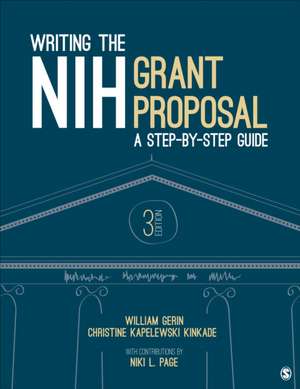Writing the NIH Grant Proposal: A Step-by-Step Guide
Autor William Gerin, Christine Kapelewski Kinkade, Niki L. Pageen Limba Engleză Paperback – 21 ian 2018
Preț: 689.92 lei
Preț vechi: 726.23 lei
-5% Nou
132.03€ • 143.37$ • 110.91£
Carte tipărită la comandă
Livrare economică 22 aprilie-06 mai
Livrare express 15-21 martie pentru 38.44 lei
Specificații
ISBN-10: 1506357733
Pagini: 232
Dimensiuni: 216 x 279 x 15 mm
Greutate: 0.56 kg
Ediția:Third Edition
Editura: SAGE Publications
Colecția Sage Publications, Inc
Locul publicării:Thousand Oaks, United States
Cuprins
About the Authors
Acknowledgments
CHAPTER 1. The National Institutes of Health
The NIH Mission
Basic NIH Facts
Other Funding Agencies
CHAPTER 2. Mentoring and Collaborative Relationships and What to Do If Things Go Awry
Developing New Collaborative Relationships
Maintaining Ongoing Collaborative Relationships
Finding and Working With a Mentor
What to Do When Interpersonal Problems Arise
CHAPTER 3. Types of Award Mechanisms
Identifying the Correct Grant Mechanism for Your Proposal . . .
The Menu
Classes of Grant Mechanisms
NIH Small Grant Program (R03)
Scope
NIH Exploratory/Developmental Research Grant Award (R21)
Factors to Consider in Identifying an Award Mechanism
Funding Opportunity Announcements (FOAs)
Research Supplements
Success Rates for Different Grant Mechanisms and Different I/Cs
The SBIR and STTR Award Mechanisms
In What Areas Is the NIH Interested?
CHAPTER 4. Preparation and Preliminary Steps
Are You Ready?
Try Out Your Ideas on Your Colleagues
The NIH Website: A Useful Resource
The NIH “Guide for Grants and Contracts”
Requests for Applications
Contacting NIH Program Staff
Choosing Your Research Team and Conducting Initial Negotiations
Summary
CHAPTER 5. Writing the Application, Part I: Scientific Content and Writing Strategies
The Scientific Content
General Notes Concerning Scientific Writing
Sections of the Proposal
The NIH Review Criteria
New Procedures Implemented by NIH Concerning Content of the Proposal
Resources
Writing the Individual Sections of the Grant Text
Research Strategy
Common Reviewers’ Criticisms
Proposal Development Timeline
Revise, Revise, Revise, Proofread, Proofread . . .
Summary
CHAPTER 6. Writing the Application, Part II: Ethics
Human Subjects Research
Use of Stem Cells
Use of Biohazards and Select Agents
Humane Care and Use of Animals
Summary
CHAPTER 7. Writing the Application, Part III: Filling Out Budgets and Other Forms
Changes to the Application Process
The Title
The Budget
The Budget Justification
Consortia and Subcontracts
SBIR/STTR Budgets
Identifying Research Opportunities and Downloading Applications Packages
The Components of the SF 424 (R&R) Form
The Budget Justification
Letters of Support and/or Collaborators/Consultants
The SF 424 Form
Summary
CHAPTER 8. Submitting the Application and the Grant Review and Award Process
Submission
The Grant Review and Award Process
Overall Impact
Scored Review Criteria
CHAPTER 9. Be Careful What You Wish For . . .
Notice of Grant Award (NGA)
Managing Your Grant Award
Setting Up the Command Structure
Bookkeeping
Yearly Progress Reports
Mea Culpa
Summary
Postscript
Glossary
Index
Notă biografică
William Gerin received his BA in Psychology from Stanislaus State College in Turlock, California in 1979, where he studied operant and classical conditioning avoidance models in animals. He became interested in the role of human interactions in emotional regulation, and received his PhD in Social Psychology from Columbia University in 1984, under the mentorship of Stanley Schachter. In 1985 Gerin undertook an NIH-sponsored postdoctoral fellowship in Cardiovascular Epidemiology at the Cornell University Medical Center. He then went on to Mount Sinal Hospital and (back to) Columbia University, when he moved his laboratory to the Pennsylvania State University, in the Department of Biobehavioral Health, where he is a Professor, and the Director of the Experimental Cardiovascular Psychophysiology Laboratory. His current research areas include the examination of acute biological responses, including blood pressure, heart rate variability, cortisol, endothelial function, and inflammatory markers, to stress and negative emotionality. His other areas of study include the role of emotional regulation in the development of hypertension and coronary heart disease, non-pharmacological interventions to lower blood pressure and improve medication adherence in culturally diverse patient populations, health disparities in the treatment and outcomes of hypertension, and the role of psyochosocial factors in cardiovascular disease.
Descriere
Writing the NIH Grant Proposal, Third Edition offers hands-on advice that simplifies, demystifies, and takes the fear out of writing a federal grant application. Acting as a virtual mentor, this book provides systematic guidance for every step of the NIH application process, including the administrative details, developing and managing collaborative relationships, budgeting, and building a research team. Helpful hints along the way provide tips from researchers who have received grants themselves.
New to this Edition:
- Much more user-friendly in response to the updated NIH website
- Covers the new Application Submission System & Interface for Submission Tracking (ASSIST) online submission form for both single and multiple projects
- Revamped advice on substantive sections of the proposal to address lowered page allowance
- Coverage of the new scoring system and reviewer reporting system
- Coverage of the usage and submission of the new SF 424 forms
